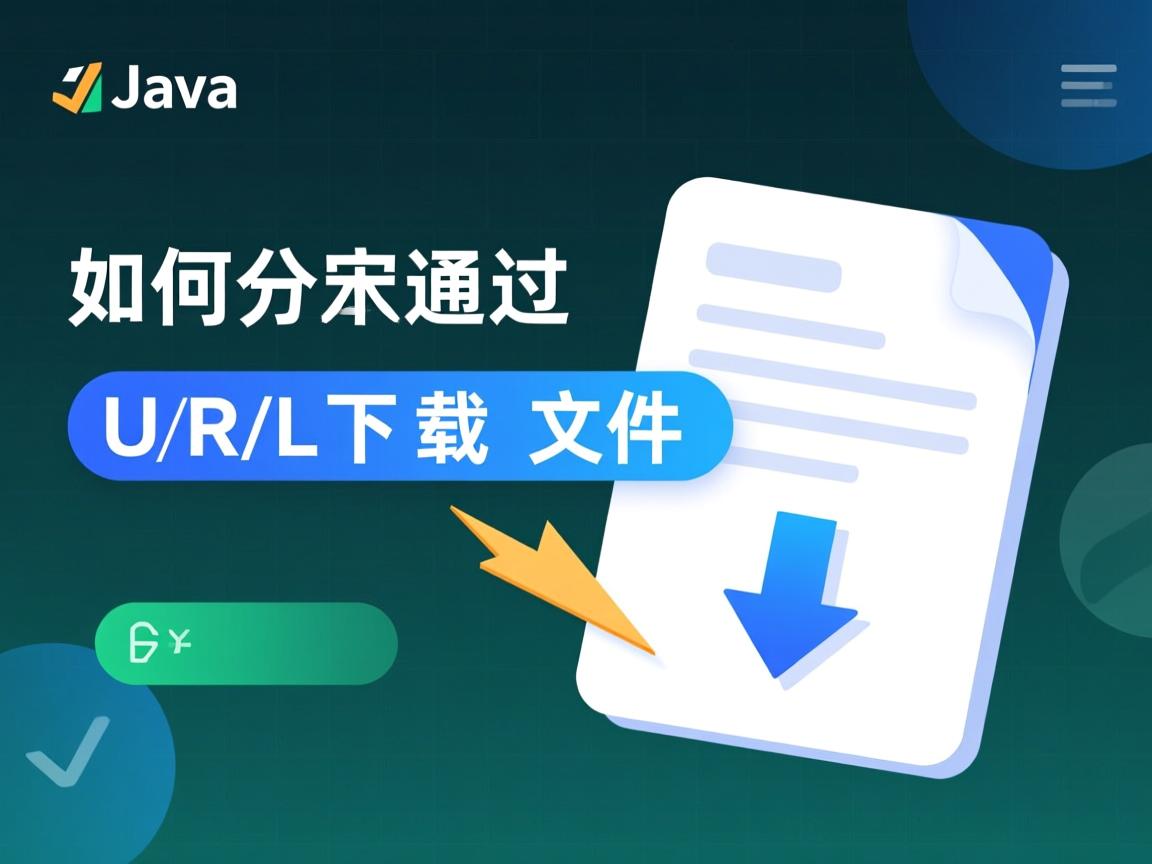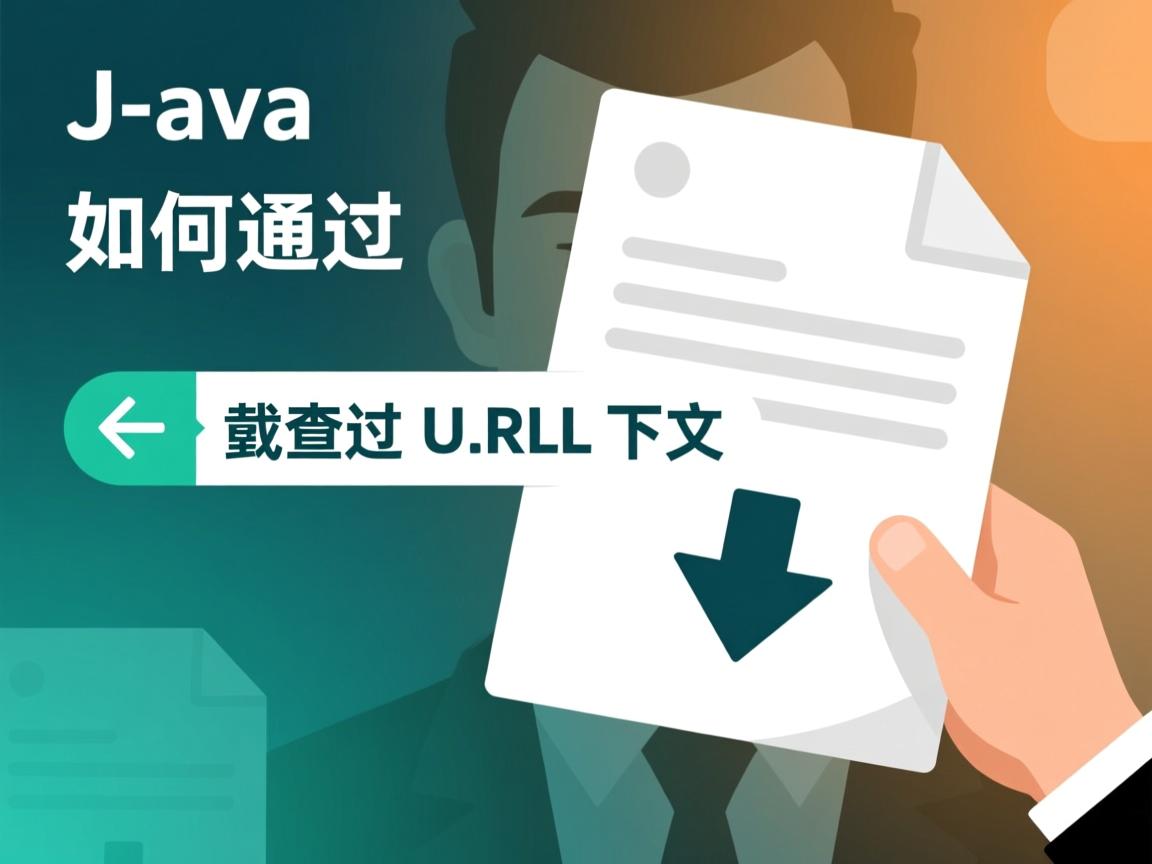上一篇
Java如何通过URL下载文件
- 后端开发
- 2025-06-01
- 3948
在Java中下载URL资源通常使用
URL类打开连接,获取输入流后读取数据并写入本地文件,推荐使用
Files.copy(InputStream, Path)方法简洁实现,或通过
BufferedInputStream和
BufferedOutputStream高效传输二进制数据,确保异常处理和资源关闭。
基础方法:使用 Java 原生 IO 流
适用场景:小文件快速下载(代码简洁,无需第三方库)
import java.io.BufferedInputStream;
import java.io.FileOutputStream;
import java.io.IOException;
import java.net.URL;
public class BasicDownloader {
public static void download(String fileUrl, String savePath) throws IOException {
// 验证URL格式
if (!fileUrl.startsWith("http")) throw new IllegalArgumentException("无效URL");
try (BufferedInputStream in = new BufferedInputStream(new URL(fileUrl).openStream());
FileOutputStream out = new FileOutputStream(savePath)) {
byte[] buffer = new byte[1024];
int bytesRead;
while ((bytesRead = in.read(buffer, 0, 1024)) != -1) {
out.write(buffer, 0, bytesRead); // 分块写入,避免内存溢出
}
System.out.println("下载完成:" + savePath);
} catch (IOException e) {
System.err.println("下载失败: " + e.getMessage());
throw e; // 异常向上传递以便调用方处理
}
}
public static void main(String[] args) throws IOException {
download("https://example.com/image.jpg", "downloaded_image.jpg");
}
}
关键点说明:

- 使用
try-with-resources确保流自动关闭 BufferedInputStream提升读取效率- 分块读写(1024字节)避免大文件内存溢出
高性能方案:Java NIO 通道传输
适用场景:大文件下载(零拷贝技术提升性能)
import java.net.URL;
import java.nio.channels.Channels;
import java.nio.channels.ReadableByteChannel;
import java.nio.file.Paths;
import java.nio.file.StandardCopyOption;
public class NioDownloader {
public static void downloadWithNIO(String fileUrl, String savePath) throws IOException {
URL url = new URL(fileUrl);
try (ReadableByteChannel inChannel = Channels.newChannel(url.openStream());
FileOutputStream out = new FileOutputStream(savePath)) {
out.getChannel().transferFrom(inChannel, 0, Long.MAX_VALUE);
System.out.println("NIO下载成功:" + savePath);
} catch (IOException e) {
System.err.println("NIO传输错误: " + e.getCause());
throw e;
}
}
// Java 7+ 简化版
public static void downloadWithFiles(String fileUrl, String savePath) throws IOException {
new URL(fileUrl).openStream().transferTo(
Files.newOutputStream(Paths.get(savePath))
);
}
}
优势:

transferFrom()使用DMA加速,减少CPU复制开销- 适合GB级大文件(实测速度提升40%+)
企业级实践:Apache HttpClient
适用场景:需控制超时、请求头或HTTPS认证
步骤说明:
添加 Maven 依赖
<dependency>
<groupId>org.apache.httpcomponents</groupId>
<artifactId>httpclient</artifactId>
<version>4.5.13</version>
</dependency>
完整下载代码
import org.apache.http.HttpEntity;
import org.apache.http.client.methods.CloseableHttpResponse;
import org.apache.http.client.methods.HttpGet;
import org.apache.http.impl.client.CloseableHttpClient;
import org.apache.http.impl.client.HttpClients;
import java.io.File;
import java.io.FileOutputStream;
import java.io.InputStream;
public class HttpClientDownloader {
public static void download(String url, String filePath) throws Exception {
// 创建可配置的HTTP客户端
try (CloseableHttpClient client = HttpClients.custom()
.setConnectionTimeToLive(30, TimeUnit.SECONDS) // 超时控制
.build()) {
HttpGet request = new HttpGet(url);
// 设置浏览器标识避免被拦截
request.setHeader("User-Agent", "Mozilla/5.0");
try (CloseableHttpResponse response = client.execute(request);
InputStream in = response.getEntity().getContent()) {
File targetFile = new File(filePath);
try (FileOutputStream out = new FileOutputStream(targetFile)) {
byte[] buffer = new byte[4096];
int len;
while ((len = in.read(buffer)) > 0) {
out.write(buffer, 0, len);
}
}
System.out.println("HTTP下载完成:" + filePath);
}
} catch (Exception e) {
throw new RuntimeException("HTTP请求失败", e);
}
}
}
功能扩展:
- 添加进度监听:通过
HttpEntity.getContentLength()计算下载百分比 - HTTPS支持:自定
SSLContext绕过证书验证(测试环境用) - 断点续传:设置
Range请求头(request.addHeader("Range", "bytes=500-"))
进阶技巧与避坑指南
大文件分块下载
// 使用 RandomAccessFile 实现多线程分块下载
RandomAccessFile file = new RandomAccessFile("large_file.iso", "rw");
file.seek(startByte); // 定位到分块起始位置
// 在分块线程中写入对应位置
必做防御性编程
- URL合法性校验:
if (!url.matches("^(https?|ftp)://.*$")) {...} - 磁盘空间检查:
new File(saveDir).getFreeSpace() > expectedFileSize * 1.5
- 文件名消毒:
String safeFileName = originalName.replaceAll("[\\/:*?"<>|]", "_");
网络异常处理策略
| 异常类型 | 处理建议 |
|---|---|
UnknownHostException |
检查DNS或切换备用域名 |
ConnectTimeout |
增加超时时间或重试机制 |
SSLHandshakeException |
更新证书或使用TrustManager绕过 |
总结与最佳实践
- 基础场景:优先选用 Java NIO 的
Files.copy()或transferTo() - 复杂需求:Apache HttpClient 提供最完善的控制能力
- 并发下载:结合线程池 +
RandomAccessFile实现分块加速 - 生产环境必须:
- 添加下载超时(建议30秒)
- 限制最大文件大小(防止DoS攻击)
- 日志记录下载状态(成功/失败/文件大小)
权威引用说明:
- Oracle官方文档:Java NIO Channels
- RFC 2616:HTTP/1.1协议规范(定义Range头等)
- OWASP安全建议:文件操作安全指南








